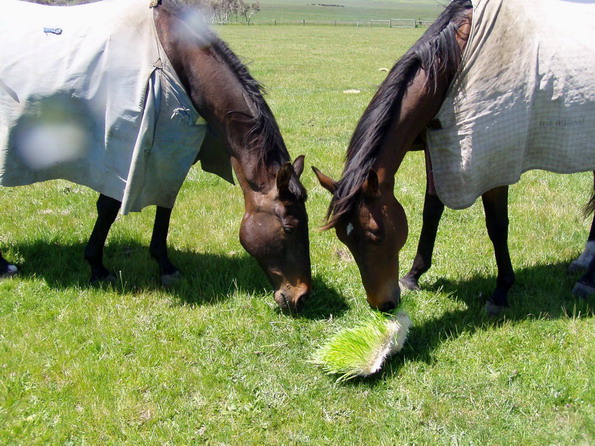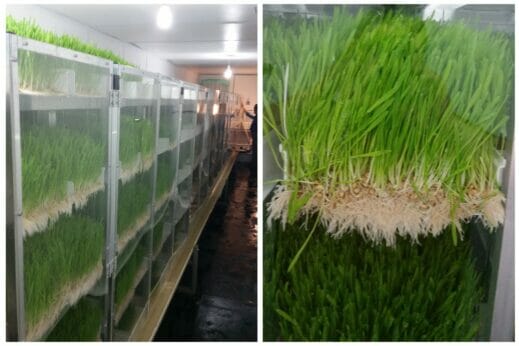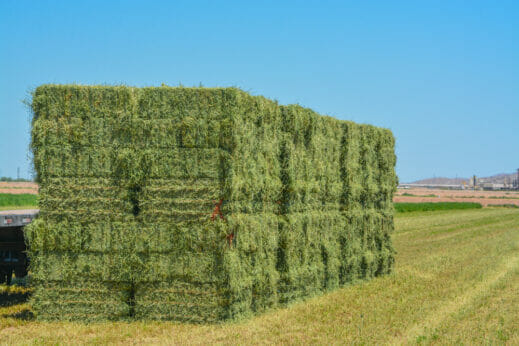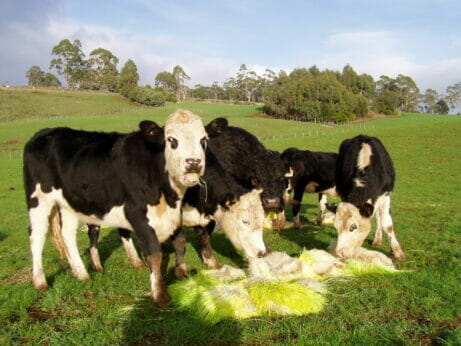With hay in the crosshairs of state water savings plans, some ranchers are switching to technologically advanced alternatives.

Agriculture sucks a whopping 80 percent of the Colorado River’s water every year. The largest contributor to that massive amount of drainage is not commonly criticized culprits such as California almonds or avocados—it’s hay.
Alfalfa hay, the nutrient-rich backbone of the dairy, beef and horse industries in the West, produces more protein per acre than any other field crop. But it comes at a great cost to the region’s water supply. Alfalfa alone siphons off more than a third of that agricultural water usage.
But there’s a potential solution on the table that some ranchers and farmers have been slowly adopting over the past decade or so. Hydroponic fodder, young tender grass grown from cereal grains in indoor systems, can grow animal feed using up to 98 percent less water than it would take to grow a comparable amount of calories in a field. Although the design and water sustainability varies from system to system, these technologically advanced setups have the potential to grow far richer animal feed using just a fraction of the water supply, land, energy and labor needed for traditional hay crops while potentially cutting greenhouse gas emissions.
Al Noorda of Cedar Fort, Utah started using fodder for his grass-fed beef cattle and horses in 2014, following years of drought at his mixed-use ranch. Although his 150 to 300 cows are turned out to graze on high-elevation native bromes, crested wheatgrass and kochia grasses during the warm weather grazing season, on dry years, he did not have enough water to grow alfalfa to feed them through the winter months.
Now that he’s adopted the technology, the 2,000 pounds per day of fodder he grows takes about 1,000 gallons of water daily. To grow that much alfalfa would require about 100 acres of land with about 50,000 gallons of water every day, he estimates. “The water needed to grow fodder is far, far, far less,” says Noorda.

Hydroponic fodder systems sow soaked grains, such as wheat or rye, into trays that are automatically watered. (Photo via FodderTech)
Noorda still grows some alfalfa to supplement his feed. And in wet years, he’s able to sell the portion that his fodder has replaced. This has significantly lowered the water use of his Spring Creek Livestock and Feed, while boosting his bottom line.
The water savings since he added the technology to his farm have been substantial, yet the benefits and cost savings have gone well beyond conserving an increasingly contentious natural resource in the West.
Noorda feeds his cattle and horses a 70 percent fodder to 30 percent dry alfalfa hay ratio. The bulk of their nutrients come from the fodder, so the hay is used for fiber roughage and to keep the stomachs moving. Because fodder boasts a far higher digestibility rate, upwards of 80 percent compared to dry hay’s 30 percent, the nutrient value is yet another advantage. Noorda says his cattle require less doctoring and his vet bills have decreased due to fewer cases of pneumonia and scours (diarrhea) in calves, who are suckling from mothers consuming the nutrient-rich feed. Plus, his cattle actually continue to gain weight through the winter months, putting on 2.5 to 2.75 pounds per day—about the same as when they’re grazing the lush spring grass at the beginning of the season. “I’m getting an extra five months of weight gain I wouldn’t otherwise get,” says Noorda.
There’s a lot of science to back up many of hydroponic fodder’s benefits.
A case study on beef cattle by FodderTech found a 27 percent reduction in feeding costs per pound of weight gain using supplementary barley sprouts in its system, costing farmers $60 to $100 per ton for fresh, green feed. Other studies have shown that hydroponic fodder’s increased digestibility could increase milk production and milk fat content in dairy cows, enhance body weight of meat animals and improve the performance of a variety of livestock. Noorda and others have found that his horses have improved stamina and shinier coats since incorporating fodder into their diets.
The rancher, who has become a huge proponent of the technology, now also works in sales, design and development for FodderTech, the longest-running hydroponic fodder system purveyor in the United States.

Agriculture accounts for 80 percent of the Colorado River’s water usage every year, and growing alfalfa makes up more than a third of that. (Photo: Shutterstock)
These modular systems, which were designed in Australia following a long drought in the 1990s, take soaked grains, such as barley, wheat or rye, which are sown into trays that are automatically watered and fed for about a week before they’re ready to serve. It takes about an hour a day of labor to maintain and clean the systems to prevent mold growth— the greatest challenge for the technology.
To keep fungus at bay, FodderTech systems must be kept inside a climate-controlled space and cleaned regularly. The water in these systems can be recirculated for maximum water efficiency; but to prevent mold growth in the sugars that are released from the sprouts, the company advises the water to be pumped out for cattle to drink or to irrigate crops. Even so, the water efficiency is far higher than traditional farming methods. “It uses somewhere between one to two percent of the water it takes to grow alfalfa hay,” says FodderTech majority owner Jon Baker. “That’s a huge water-saving potential.”
Mold aside, the other drawback to these commercial systems is the initial cost. A 200-pound-a-day system, which is enough to feed 10 horses or a just over a handful of beef cattle, starts at between $5,000 and $6,000, before even building out the climate-controlled space in which it will need to be housed. According to Baker, the cost savings of reducing increasingly expensive hay bills means these FodderTech systems tend to pay for themselves fairly quickly, somewhere between 12 and 18 months.
Some handy farmers opt to build their own systems, but there are also other brands on the market including FarmTek, CropKing and Brianna Noble’s Urban Cowgirl Ranch.
Noble has designed her systems specifically for the horses she keeps on her 40-acre Bay Area ranch, so there are some differences in the setup. Everything is automated and kept in a humidity- and temperature-controlled room that’s maintained at 68 and 72 degrees. To inhibit mold growth, Noble prefers removable trays that can be pressure washed with a mix of bleach and soap, which she has found easier to manage at her mostly volunteer-run facility. Noble also chose to forego grow lights for the sugar-sensitive equines she’s feeding. “Cattle aren’t sensitive to sugar the way horses are,” she says.

Cattle eating hydroponically grown fodder. (Photo via FodderTech)
Nobles’ systems, which use recirculated reverse osmosis treated water that eventually gets sent to cattle, cost $4,500 per horse and, according to her estimates, take two to three years to pay for themselves when fodder is used as a third of the animal’s diet. Noble, too, claims she’s saved on vet bills, especially with her old horses who are prone to colic. Subbing out a chunk of the meadow hay she feeds at $29 a bale has significantly decreased the costs to run her business. While hay prices have increased across the United States—cheaper alfalfa skyrocketed from an average of $211 per ton in January 2022 to a record-breaking $281 per ton in October 2022—Noble says that hay prices have nearly doubled in California.
Chances are that instability in the hay market isn’t changing any time soon. As part of California, Arizona and Nevada’s agreement to stop using 3 million acre-feet of the Colorado River—approximately a trillion gallons—as part of the Colorado River water deal signed in May, the states have agreed to pay farmers $1.2 billion to stop growing hay.
Adoption of hydroponic fodder has been very slowly gaining steam among ranchers, but it may begin to pick up as states start to see the benefits of increasing incentives to save water and other natural resources. Earlier this year, the Utah legislature clarified an existing law to allow these systems to qualify for the Agriculture Resource Development Loan Program.
Whether or not other states will follow suit or begin to offer grants remains to be seen. But for the farmers who already have moved over, like Noble and Noorda, it has helped them to significantly reduce their water footprint while helping to weather the financial volatility that’s inherent in agriculture. “My general philosophy is it’s not how much money you make in farming, it’s how much you save,” says Noorda. “Fodder is a tool.”
Never should’ve been growing alfalfa in the first place. And I see Noble’s operation runs mostly on volunteer labor, so her numbers ($4,500 per horse and, according to her estimates, takes two to three years to pay for themselves) are pretty much useless. Just a thought, but maybe we’re trying to farm land that isn’t meant to be farmed. Brazil (cough cough).
Sara; Interesting article. Great story. However, does it hold water? (pun intended). I think not. There are lots of opportunities to save water in fodder production (including deficit irrigation strategies), but this isn’t one of them. We were able to do some independent studies on hydroponic forage some ten years ago. Even leaving aside the demand for energy and cost of infrastructure (buildings, containers, lights, etc.), the economics of this method don’t really work. The hydroponic fodder actually decreases feed supply (since sprouted grain loses carbohydrates during sprouting). It’s cheaper to buy hay. Remember to adjust for dry matter content… Read more »
Sounds real good to me. Can’t believe hay is so expensive. Used to sell it for $1/bale way back when.